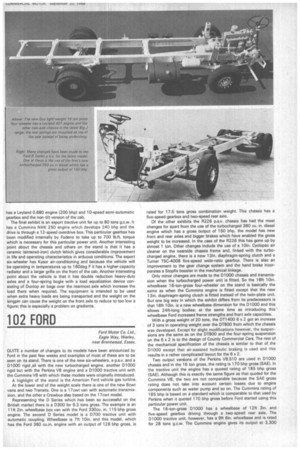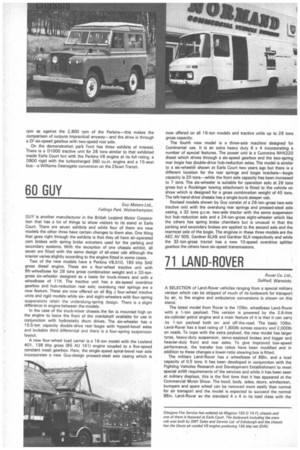102 FORD
Page 131

Page 132

If you've noticed an error in this article please click here to report it so we can fix it.
Ford Motor Co. Ltd., Eagle Way, Walley, near Brentwood, Essex.
QUITE a number of changes to its models have been announced by Ford in the past few weeks and examples of most of these are to be seen on its stand. There is one of the new six-wheelers, a p.s.v. and a D1000 rigid all with the new turbocharged engine, another D1000 rigid but with the Perkins V8 engine and a D1000 tractive unit with the Cummins V8 with which these models were originally introduced.
A highlight of the stand is the American Ford vehicle gas turbine.
At the lower end of the weight scale there is one of the new 8cwt vans and two Transits. One is a 17cwt van with automatic transmission, and the other a Crewbus also based on the 17cwt model.
Representing the D Series which has been so successful on the British market there is a 0300 for 6.3 tons gross. The example is an 1111 2in. wheelbase box van with the Ford 330cu. in. 115 bhp gross engine. The second D Series model is a D700 tractive unit with automatic coupling. Wheelbase is 7ft 10in, and this model, which has the Ford 360 cu.in. engine with an output of 128 bhp gross, is rated for 17.5 tons gross combination weight. This chassis has a five-speed gearbox and two-speed rear axle.
Of the other exhibits the R226 p.s.v. chassis has had the most changes for apart from the use of the turbocharged 360 cu. in. diesel engine which has a gross output of 150 bhp, the model has new front and rear axles and bigger brakes which have enabled the gross weight to be increased. In the case of the R226 this has gone up by almost 1 ton. Other changes include the use of a 10in. Cyclopac air cleaner on the nearside chassis frame and, linked with the turbocharged engine, there is a new 13in. diaphragm-spring clutch and a Turner T5C-4008 five-speed wide-ratio gearbox. There is also an improvement to the gear change system and the hand brake incorporates a Stopfix booster in the mechanical linkage.
Only minor changes are made to the D1000 chassis and transmission when the turbocharged power unit is fitted. So the 18ft 10in. wheelbase 16-ton-gross four-wheeler on the stand is basically the same as when the Cummins engine is fitted except that the new 13in. diaphragm-spring clutch is fitted instead of the twin-plate unit. But one big way in which the exhibit differs from its predecessors is that 18ft 10in, is a new wheelbase dimension for the D1000 and this allows 2411-long bodies; at the same time as introducing this wheelbase Ford increased frame strengths and front axle capacities.
With a gross weight of 20 tons, the DT1400 6 x 2 got an increase of 3 tons in operating weight over the 01800 from which the chassis was developed. Except for slight modifications however, the suspensions are the same as on the DT800 and the four-spring suspension on the 6 x 2 is to the design of County Commercial Cars. The rest of the mechanical specification of the chassis is similar to that of the 01000 except that air-assisted hydraulic braking is used and this results in a rather complicated layout for the 6 x 2.
Two output versions of the Perkins V8.510 are used in 01000 chassis and in the 16 ton gross, the rating is 170 bhp gross (SAE). In the tractive unit the engine has a quoted rating of 185 bhp gross (SAE). Although this is exactly the same figure as that quoted for the Cummins V8, the two are not comparable because the SAE gross rating does not take into account certain losses due to engine components such as water pump and so on. The Cummins rating of 185 bhp is based on a standard which is comparable to that used by Perkins when it quoted 170 bhp gross before Ford started using this particular power unit.
The 16-ton-gross D1000 has a wheelbase of 12ft 3in. and five-speed gearbox driving through a two-speed rear axle. The D1000 tractive unit, however, has a 9ft 6in. wheelbase and is rated for 28 tons g.c.w. The Cummins engine gives its output at 3,300 rpm as against the 2,800 rpm of the Perkins—this makes the comparison of outputs impractical anyway—and the drive is through a ZF six-speed gearbox with two-speed rear axle.
On the demonstration park Ford has three exhibits of interest. There is a D1000 tractive unit for 28 tons similar to that exhibited inside Earls Court but with the Perkins VB engine at its full rating, a D800 rigid with the turbocharged 360 cu.in. engine and a 15-seat bus—a Williams Deansgate conversion on the 25cwt Transit.


















































































































































































































































































































































































